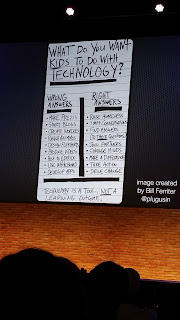June ISTE Conference
In June I flew to Philadephia, USA for the ISTE conference with 20 000 other teachers. It was huge to say the least. I spoke at the TeachMeet which was fantastic and I would say that the TeachMeet was a highlight event for me. I was able to connect with some other Aussie teachers who I know now will be life long friends.
Some of the key themes from ISTE:
- gamification will drive learning in the future,
- students will learn more effectively when they are having fun,
- augmented reality is a developing area for education,
- there is tension around the use of Google products, social media and student privacy,
- collaboration that is relevant and meaningful to students connects with them at a deeper level and develops long term communication skills
- developing communication and problem solving skills for students is key to survival in an information society.
September Engage Conference
A month ago I also was able to attend the inaugural Engage conference for TAFE NSW. It was great to hear and see how are others are incorporating blended learning into their practice and how they are developing courses for online learning. There was great conversation about learning spaces and the integration of technology in these spaces. Mike Heppell was insightful in the direction that online learning needs to take and solid pedagogy must drive learning and much planning needs to take place before courses are delivered.
October Practical Pedagogies
Finally I have just returned from France where I presented at the Practical Pedagogies conference in Toulouse. I really enjoyed the rich conversation with a very European perspective and it was great to hear about the challenges and success of teachers in Europe.
There seems to be similar ways that teachers are using technology and blended learning in the classroom and there is a developing industry of educational technology consultants or instructional designers to support teachers as they develop blended learning resources. I must say that the USA is definitely leading the charge on this however Britain is really adopting this kind of support much more so than Australia.
 |
| Image at bigstockphotos.com |
Ewan McInsosh has much to say about virtual and physical learning spaces and I have found the 7 spaces for learning helpful to create a holistic approach to learning.
The Seven Spaces of Technology in School Environments from NoTosh on Vimeo.
Thornburg's Primordial Learning spaces also can be helpful in assisting students with critical thinking and problem solving skills.
Campfire, Watering hole and Cave.
Data Usage
Another key trend is data usage. Now more than ever we can give students more feedback about their work and we can track areas for improvement like never before. Keeping data that can provide overall insight into how a student are going in specific learning areas will be helpful in the future to assist students with areas for development that can be picked up quickly and more precisely.
Safety
There is still concern over students rights and privacy in cyber space and there are many schools in Europe who are unsure about how Google is going about keeping the students data and what they are going to do with it. Is seems as though this is an area that is still developing and whilst many schools are using Google's Apps for Education there are still some who aren't convinced that this is the way to go.
Problem Solving and Critical Thinking
I must say that at all three conferences there was a greater emphasis on this point than I have seen
 |
| Image at bigstockphotos.com |
Australia is a player
Lastly Australia is a player in the areas of education technology. This was clearly seen at all three conferences and through rich conversations I can see that Australia has been engaging in quality education practice as well. There were many teachers who felt that #AussieEdchat was an excellent place to find resources and that many of the Australian twitter chats are being followed around the world. Many conversations that I had included discussion about how Australia was being innovative and creative in the education technology space and the world is watching and taking note.
These last few months have been educational rich as I explored what was going on around the world in the area of education technology. What I found is a dedicated group of enthusiastic and passionate teachers like myself who strive everyday to care for their students and engage them in learning activities. I also have found a spirit of generosity to share and support fellow teachers and this global perspective makes the world very small as education communities are engaging with each other like never before.
This is but a small brain dump and I hope to blog more about my experiences over the coming weeks.
Until next time,
K









